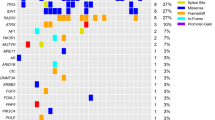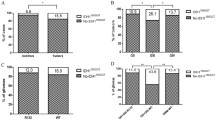Abstract
Glioblastoma multiforme (GBM) represents the most common and aggressive type of primary neoplasms of the central nervous system. The PTEN (phosphatase, tensin homologue, deleted on chromosome TEN; MIM # 601728) tumor suppressor gene has an essential biological role in the formation of glioblastomas. It is known that there are variations in genetic alterations in tumors that develop in patients with different ethnic backgrounds and because there is no study evaluating PTEN mutation in Turkish patients with GBM, we aimed to realize the present study. We investigated 62 GBM tumors for mutations of the PTEN gene using single strand conformational polymorphism (SSCP) method followed by DNA sequencing. As a result of our investigation, PTEN mutations were detected in 15 of 62 tumors (24.19%). Nine different sequence variants were identified: one novel promoter site mutation (5′UTR −9C→T), one novel intronic mutation (IVS2-2delA), four novel point mutations (61A→G, 105T→G, 248C→G, and 364C→G), two novel frameshift mutations (213delC) and 378delGATA) and one previously reported global exonic transition type mutation (129G→A). Since the majority of PTEN mutations identified in the present study are novel, we believe that these alterations may be specific to Turkish population. Furthermore, though no significant correlation was found between PTEN mutations and histopathological properties of GBM tumors, our findings indicate that localizations of mutations in PTEN gene may have an effect on clinical aggressiveness of GBM tumors.

Similar content being viewed by others
Abbreviations
- SSCP:
-
single strand conformational polymorphism
- PCR:
-
polymerase chain reaction
- LOH:
-
loss of heterozygosity
- IVS:
-
intervening sequence
References
Turkish Ministry of Health (2000) Republic of Turkey Health Statistics, Turkish Ministry of Health. www.saglik.gov.tr/istatistikler
Lantos PL, Vanderberg SR, Kleihues P (1997) Tumours of the nervous system. In: Graham DI, Lantos PL (eds) Greenfield’s neuropatholology, 6th edn. Arnold, pp 600–626
Zhou XP, Li YJ, Hoang-Xuan K, Laurent-Puig P, Mokhtari K, Longy M, Sanson M, Delattre JY, Thomas G, Hamelin R (1999) Mutational analysis of the PTEN gene in gliomas: molecular and pathological correlations. Int J Cancer (Pred. Oncol.) 84:150–154
CBTRUS (2000) Statistical report: primary brain tumors in the united states, 1992–1997, published by the central brain tumor registration of the United States
Ohgaki H, Dessen P, Jourde B, Hoursmann S, Nishikawa T, Di Patre PL, Burkhard C, Schüler D, Probst-Hensch NM, Maiorka PC, Baeza N, Pisani P, Yonekawa Y, Yasargil MG, Lütolf UM, Kleihues P (2004) Genetic pathways to glioblastoma: a population-based study. Cancer Res 64:6892–6899
Ichimura K, Ohgaki H, Kleihues P, Collins VP (2004) Molecular pathogenesis of astrocytic tumours. J Neurooncol 70:137–160
Collins VP (2004) Brain tumours: classification and genes. J Neurol Neurosurg Psychiatry 75(suppl 2):2–11
Batchelor TT, Betensky RA, Esposito JM, Pham LD, Dorfman MV, Piscatelli N, Jhung S, Rhee D, Louis DN (2004) Age-dependent prognostic effects of genetic alterations in glioblastoma. Clin Cancer Res 10:228–233
Hill C, Hunter SB, Brat DJ (2003) Genetic markers in glioblastoma: prognostic significance and future therapeutic implications. Adv Anat Pathol 10:212–17
Ohgaki H, Kleihues P (2005) Population-based studies on incidence, survival rates, and genetic alterations in astrocytic and oligodendroglial gliomas. J Neuropathol Exp Neurol 64:479–489
Zhou YH, Tan F, Hess KR, Yung WKA (2003) The expression of PAX6, PTEN, vascular endothelial growth factor, and epidermal growth factor reseptor in gliomas: relationship to tumor grade and survival. Clin Cancer Res 9:3369–3375
Eng C (2003) PTEN: one gene, many syndromes. Human Mutat 22:183–198
Kleihues P, Burger PC, Scheithauer BW (1993) Histological typing of tumors of the central nervous system. In: Kleihues P, Burger PC, Scheithaver BW (eds) International histological classification of tumors. World Health Organization, Geneva
Kraus JA, Glesmann N, Beck M, Krex D, Klockgether T, Schackert G, Schlegel U (2000) Molecular analysis of the PTEN, TP53, and CDKN2A tumor suppressor genes in long-term survivors of glioblastoma multiforme. J Neuroncol 48:89–94
Knobbe CB, Merlo A, Reifenberger F (2002) PTEN signaling in gliomas. Neurooncol 4:196–211
Fukushima T, Favereaux A, Huang H, Shimizu T, Yonekawa Y, Nakazato Y, Ohagki H (2006) Genetic alterations in primary glioblastomas in Japan. J Neuropathol Exp Neurol 65(1):12–18
www.ensembl.org/Homo_sapiens/protview?db=core;peptide=ENSP00000361021
Ishihara H, Sasaoka T, Kagawa S, Murakami S, Fukui K, Kawagishi Y, Yamazaki K, Sato A, Iwata M, Urakaze M, Ishiki M, Wada T, Yaguchi S, Tsuneki H, Kimura I, Kobayashi M (2003) Association of the polymorphisms in the 5′-untranslated region of PTEN gene with type 2 diabetes in a Japanase population. FEBS Lett 554:450–454
Agrawal S, Pilarski R, Eng C (2005) Different splicing defects lead to differential effects downstream of the lipid and protein phosphatase activities of PTEN. Human Mol Genet 14(16):2459–2468
Furnari FB, Lin H, Huang HJS, Cavenee WK (1997) Growth suppression of glioma cells by PTEN requires a functional phosphatase catalytic domain. Proc Natl Acad Sci USA 94:12479–12484
Georgescu MM, Kirsch KH, Kaloudis P, Yang H, Pavletich NP, Hanafusa H (2000) Stabilization and productive positioning roles of the C2 domain of PTEN tumor suppressor. Cancer Res 60:7033–7038
Georgescu MM, Kirsch KH, Akagi T, Shishido T, Hanafusa H (1999) The tumor-suppressor activity of PTEN is regulated by its carboxyl-terminal region. Proc Natl Acad Sci USA 96: 10182–10187
Kato H, Kato S, Kumabe T, Sonoda Y, Yoshimoto T, Kato S, Han SY, Suzuki T, Shibata H, Kanamaru R, Ishioka C (2000) Functional evaluation of p53 and PTEN gene mutations in Gliomas. Clin Cancer Res 6:3937–3943
Acknowledgements
We thank to Prizma and Elips Ltds for their support in supplying the experimental equipment.
Author information
Authors and Affiliations
Corresponding author
Rights and permissions
About this article
Cite this article
Tunca, B., Bekar, A., Cecener, G. et al. Impact of novel PTEN mutations in Turkish patients with glioblastoma multiforme. J Neurooncol 82, 263–269 (2007). https://doi.org/10.1007/s11060-006-9293-z
Received:
Accepted:
Published:
Issue Date:
DOI: https://doi.org/10.1007/s11060-006-9293-z




